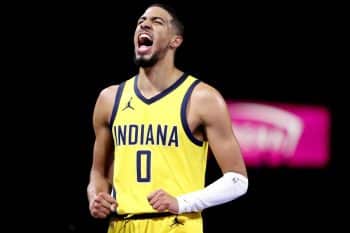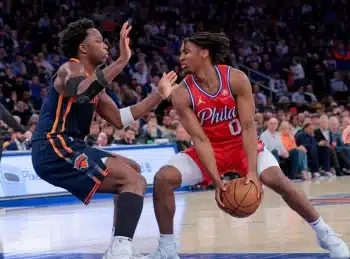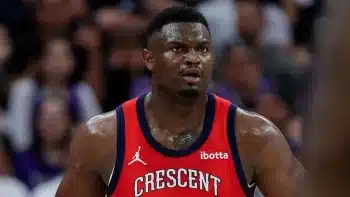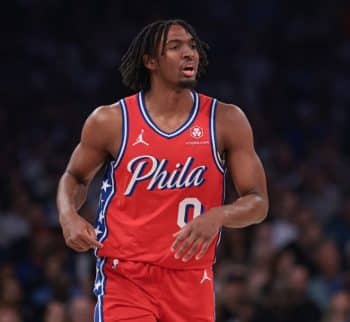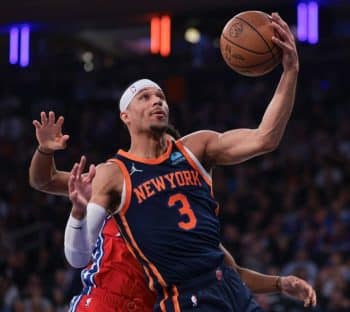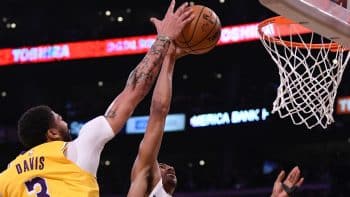NBA
NBA Saturday: Exploring DeAndre Jordan’s Offensive Role in Dallas

On Friday, DeAndre Jordan committed to a four-year, $80-million deal with the Dallas Mavericks. Though Jordan was pursued by many teams, it was widely understood that he was choosing between his former team, the Los Angeles Clippers, and the Mavericks. As soon as Jordan’s decision was reported, there was league-wide debate over why Jordan ultimately chose the Mavericks over the team he spent the first seven years of his career with, which had recently added Paul Pierce and Lance Stephenson to the roster.
Kevin Arnovitz of ESPN wrote about the recruiting process and what led to Jordan’s choice to leave Los Angeles. As Arnovitz detailed, there were several things that contributed to Jordan’s decision. However, the most significant reason seems to have been Jordan’s desire to be more featured on offense.
“All the while, the Mavericks, Lakers and Knicks each gave compelling basketball presentations about how their respective offenses could accommodate Jordan with nifty pick-and-roll sets and, in the Mavericks’ case, play calls that leveraged Dirk Nowitzki’s range to give Jordan baseline seals and duck-ins. It was everything Jordan had envisioned: a Dwight Howard-size role in an NBA offense.”
This is where Jordan’s line of thinking makes the most sense. In Los Angeles, Chris Paul and Blake Griffin will always be options one and two, with Jordan getting the majority of his points off of put-backs and opportunistic lobs. While those roles made sense for the team, which was a historic playoff collapse away from meeting the Golden State Warriors in the Western Conference Finals, it didn’t give Jordan the opportunity to explore his full potential. The Clippers most likely gave Jordan the better chance of contending (unless the Mavericks make some serious moves to bolster their roster), but Jordan is within his right as a free agent to go wherever he pleases. Reasonable people can debate over whether a player should prioritize winning a championship over personal accolades, but at age 26, and after playing a full seven years with the Clippers, now was the time for Jordan to make a move like this.
Let’s take a look at what Jordan’s offensive role will most likely be in like next season to see and understand why he was so attracted to the Mavericks’ pitch to him.
In November of last year, Zach Lowe of Grantland wrote an excellent breakdown of the Mavericks’ offense, thoroughly explaining how and why it was so efficient. In his breakdown, Lowe wrote that the pick-and-roll was the staple the Mavericks’ offense, which, at the time, featured Brandan Wright and Tyson Chandler (two hyper-efficient big men in the pick-and-roll). Every team now runs the pick-and-roll to some extent, but the Mavericks were more creative with it than most. Mavericks head coach Rick Carlisle trusted his players to read and react and run multiple variations of the same basic sets, which often confused opponents as to who was the weak-side defender and led to open shots as a result.
The hyper-efficient offense eventually cooled off, however, as the Mavericks traded several players, including Wright, Jameer Nelson and Jae Crowder (along with a 2015 first-round draft pick and a future second-round pick), for Rajon Rondo in December. Rondo, a complete non-shooter, cramped the spacing of the Mavericks’ offense, and never adjusted to playing off the ball for long stretches, but the Mavericks still managed to finish the regular season with a top-five offense regardless.
But the offensive-model prior to the trade for Rondo was performing at a historically great level, and a huge part of that was Chandler. One of the most basic, but effective things the Mavericks did was enter quick pick-and-rolls early off of a defensive stop. Often times, Dirk and Chandler would set a double-screen, which would drag defenders to Dirk, allowing Chandler to roll to the rim for easy lobs. The same strategy should apply to Jordan next season, who is a younger, more athletic version of Chandler. And this is just one basic principle the Mavericks used last season, and it just the tip of the iceberg for Jordan.
This is where the pitch to Jordan most likely became so intriguing. In Los Angeles, Jordan was the featured roll man 12 percent of the time, whereas Chandler was the roll man 21.5 percent of the time in Dallas. Unlike Jordan with the Clippers, Chandler was a primary part of the offensive attack, rather than ancillary to it. Chandler scored an elite 1.41 points per possession (97.7 percentile) out of these plays, while Jordan scored 1.36 points (95.5 percentile).
Chart Courtesy of NBA.com
The pitch was clear: Come to Dallas and you will be put in the pick-and-roll over and over, which you are great at. Instead of waiting on the baseline to pick up Paul and Griffin’s scraps, you’ll be a part of the primary action and will create space and scoring opportunities for your teammates. Dirk and the rest of the players will work off of you and you will be the driving force behind one of the league’s best offenses.
This is why the Mavericks were willing to pay shooting guard Wesley Matthews roughly $64 million over four years. Matthews, who is recovering from a ruptured Achilles, is one of the deadliest shooters in the league. If he returns to full strength (which is not a sure thing), he will help spread the floor alongside Chandler Parsons and Dirk Nowitzki, who will all benefit from Jordan’s efficiency in the pick-and-roll.
Just like last season, the Mavericks will bank on the idea that they don’t need a top-level point guard to run their offense. With Jameer Nelson and Monta Ellis in the back-court, the Mavericks were whipping the ball across the court, passing up good shots in search of great shots. There was no need for an elite point guard to break down defenses to setup teammates.
“We try not to call any plays if we can,” Carlisle told Lowe last year. “We want to be difficult to defend, and the more random we can make it, the more difficult it will be for defenses.”
The offense allowed for each player to be a setup man, a distributor in a sense as the ball never stuck in any one person’s hands. However, the Mavericks abandoned this idea when they surrendered Wright, Nelson and Crowder for Rajon Rondo (an obviously terrible move in hindsight), which led to a decline in their overall play. But before the trade, Dallas had proven it could run a hyper-efficient offense without an elite point guard, which is something they obviously convinced Jordan they could do again considering their current point guard depth. There’s no guarantee that the Mavericks can recapture the potency of their early-season offense, but Jordan is banking on it, and it’s not hard to understand why.
The adjustment won’t be seamless for Jordan, however. Chandler explained to Lowe that when he received the ball at the elbow on a pitch play, he had to read the defense and determine which cutter to pass to. He was responsible for deciding how to best attack the defense.
“It’s all misdirection on that play,” Chandler explained. “And then it’s just reading the defense. It’s kind of like I’m an option quarterback.”
In Jordan’s seven year career, he has never been put in a play-making position. His role more often had him holding the ball above the three-point-arc, setting a screen for a curling J.J. Redick, and handing the ball off while Redick would launch an open, leaning three-pointer. Or he would often simply wait near the basket to collect offensive rebounds. In Dallas, Jordan will have to improve his ability to read defenses and make the appropriate pass, which is not something he has ever really been asked to do or proven to be capable of.
There are some additional things that could prevent Jordan from finding success in a bigger offensive role in Dallas, at least early on. First, he is leaving a team with the best passing point guard in the league in Paul, who is an expert at setting up teammates for easy baskets. A huge percentage of Jordan’s shots these last few seasons have come as a direct result of Paul drawing double-teams, breaking down defenders and finding Jordan wide open under or above the rim. And when Paul wasn’t directly lobbing the ball to Jordan, he was often times whipping the ball to Griffin out of a pick-and-roll, who would then take an aggressive dribble or two towards the basket, drawing multiple help-defenders to prevent him from throwing down a highlight reel worthy dunk. With multiple defenders coming his way, Griffin would often throw accurate lobs to Jordan, who would patiently wait on the baseline for the Paul-Griffin pick-and-roll to unfold, knowing that there would be an easy scoring opportunity waiting for him if the defense got sucked in by Griffin.
Also, he is leaving a team where he was the third or fourth option and joining a team where he will be a primary option on offense. Teams will know that Dallas is trying to set him up to score, and will be able to focus their defense to stop him. With the exception of the times Griffin was out with an injury, defenses for the most part never really needed to put a concerted effort towards stopping Jordan, who averaged a career-high 11.5 points per game last season.
In addition, he is joining a Mavs teams that has Devin Harris slotted in the starting point guard position, with Raymond Felton at backup point guard. He also is banking on the Matthews’ returning to full health (which has not historically happened with players after rupturing an Achilles), Parsons fully recovering from what may have been microfracture surgery on his ailing knee (another career-threatening injury), and the ongoing effectiveness of a 37-year-old Nowitzki. That roster, as it stands today, is unlikely to contend for a championship. But, Jordan now has more of an opportunity to show he can be “the man,” and if the Mavericks can recapture the adaptive, hard to predict offense that it was torching teams with before trading for Rondo, then Jordan could potentially put up numbers like he did in February when Griffin was out with a staph infection. Whether that will end up happening is unclear, but what is clear is that opportunity would never be present in Los Angeles so long as Paul and Griffin were on the same team.
Yesterday, Mark Cuban said that the Mavericks consider Jordan to be “Shaq-like” and that he could develop into a franchise player in Dallas. Well, Jordan may eventually develop into a franchise player, but it’s not because he is Shaq-like in the way he actually plays the game. Up to this point in his career, Jordan has zero reliable post moves and rushes when in the post, often fumbling the ball or missing easy layups and hook shots. Fortunately, the Mavericks aren’t going to post up Jordan much. That isn’t how they played last season with Chandler, and there’s no reason to do so now with Jordan. But that’s okay, Jordan doesn’t need to develop a post-game to be featured on offense. His devastating efficiency in the pick-and-roll, coupled with Carlisle’s innovative offensive principles will potentially make Jordan an even bigger threat than he was these last few seasons in Los Angeles.
This was the vision that drew Jordan to Dallas and left the Clippers scrambling to replace their former center.

